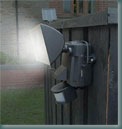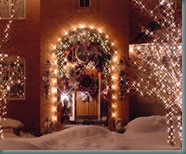Outdoor lighting is useful for adding security and charm to your home's exterior. But when overdone, it can be costly to operate. Fortunately, there are several steps that can be taken to reduce your energy consumption when it comes to outdoor lighting. Here are some suggestions:
Replace standard current lighting with low-voltage lighting. Low-voltage lighting kits come with transformers that safely reduce standard household current (120V) to a much lower level (12V) for lighting. This works well for secondary or pathway lighting.
 Go a step further by switching to solar powered outdoor lights. These lights are easy to install and are environmentally friendly because they provide free, renewable energy by means of photovoltaic cells that convert streaming daylight into stored electricity. The stored energy is then released at night when the sun is no longer supplying power to it. These are particularly useful in remote areas where utility service is not easily accessed.
Go a step further by switching to solar powered outdoor lights. These lights are easy to install and are environmentally friendly because they provide free, renewable energy by means of photovoltaic cells that convert streaming daylight into stored electricity. The stored energy is then released at night when the sun is no longer supplying power to it. These are particularly useful in remote areas where utility service is not easily accessed.
Outdoor lights that are left on all night may unnecessarily waste  energy and disturb wildlife. Therefore, reduce the amount of time lights are on, but not being used, by installing motion-activated fixtures or plug-in outdoor timers. Solar powered motion sensors and low voltage lighting kits on timers will increase your energy savings even more.
energy and disturb wildlife. Therefore, reduce the amount of time lights are on, but not being used, by installing motion-activated fixtures or plug-in outdoor timers. Solar powered motion sensors and low voltage lighting kits on timers will increase your energy savings even more.
Use tube fluorescent and energy efficient compact fluorescent lights (CFLs) in fixtures not exposed to water or moisture. Although CFLs cost a bit more initially, they pay for themselves by the energy they save over their lifetime, which is significantly longer than incandescent bulbs. Be sure, though, to buy a lamp with a cold weather ballast if you live in a cold climate, since standard CFLs may not work well below 40°F.
Also consider high-intensity discharge (HID) or low-pressure sodium lights. However, both HID lighting and low-pressure sodium lamps require up to ten minutes to start and have to cool before they can restart, so they are not suitable for use with motion detectors. They are most suitable for applications where they stay on for hours at a time. 
Finally, light emitting diodes (LED) are highly energy efficient and work especially well for holiday lighting.


No comments:
Post a Comment